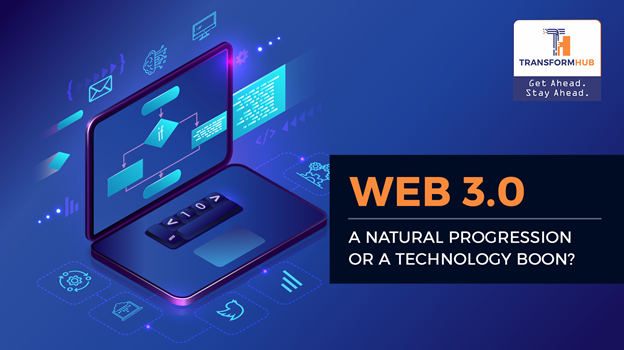Web 3.0 - What Business Leaders Should Know to Embrace the Next Era of Computing
We discussed at length about Web 3.0 in one of our blogs earlier.
We iterated how it was a monumental shift from its predecessor Web 2.0 and the opportunities it had in store for people and businesses.
Touted as the next era of computing, it promises to enhance the customer experience as well as business value.
Talk to any cloud computing company and you would know Web 3.0 is quickly transcending the impact of Web 2.0 changing the technology landscape faster than ever.
It's time to look at it critically, understand the emerging technology trends, and how we can leverage it effectively to make the most of it while building roadmaps for diverse products.
New storage solutions have emerged, blockchain has become pivotal, and the Web 3.0 decentralized cloud storage system is keeping cloud engineering services on their toes.
So let’s dive in right away to understand what this new era of computing is all about.
Decentralization is now becoming the norm
Businesses and individuals across the world we're in for the most agonizing wait of their lives as Facebook struggled to revive its most popular social networking platforms including WhatsApp, Instagram, and Messenger.
It was also the time when others like Twitter and TikTok rose by nearly 200%.
The spotlight was back again on the need for having decentralized networks as privacy breaches and security concerns took center stage for discussions among industry experts.
Business leaders are now looking up to Web 3.0-powered models to enhance the tech experience while ensuring security.
Following Facebook's massive 6-hour outage, this is what Colin Pape, founder of decentralized search engine Presearch had to say, "Web 3.0 needs to build beyond the issues that cause this outage: centralization. Adopting instead the decentralized approach that puts the power back into the hands of the users and incentivizes them to help maintain a digital world that is safer, more secure, and most importantly, online when you need it to be.”
The emergence of cryptocurrency and blockchain technology coupled with next-generation initiatives are now making way for a secure ecosystem eliminating gatekeepers and middlemen from global commerce.
The ecosystem so created will be:
- Trustless
- Permissionless
- Autonomous
Trustless
Unlike in the traditional settings where only permissioned servers are able to run the application backend, the trustless infrastructure will distribute trust across all the nodes in the system.
Every node will be required to act responsibly rendering full cooperation to people, machines, and businesses without necessitating an intermediary.
Permissionless
Traditionally, digital products have always relied on permissioned access which means an online bank gets to decide your eligibility, Twitter determines if you can be part of their community, and so on.
But as a product owner, you would want to have complete control to decide who can use your digital products and that's exactly what Web 3.0 aims to empower you with.
In other words, anyone that meets the basic criteria of a system can be an active part of it.
For instance, as long as you meet the collateral requirements, you can get a loan on popular borrowing platforms like Aave or Compound due to the digitization of all the assets involved in these transactions.
Autonomous
Decentralized systems shift the responsibility to users making them responsible for managing and safeguarding their own data.
So if users are provided a key to access their assets on a blockchain, the onus is on them to ensure they protect this private key.
Decentralization also gives businesses the autonomy to realign the economic interests of all stakeholders including users, operators, and customers thereby minimizing friction.
Artificial Intelligence (AI) and Machine Learning (ML) will make decisions instead of human beings
The proliferation of AI and ML in our lives is known to all. AI and ML algorithms now dictate all small and big decisions, be it for home appliances, climate modeling, or car manufacturing.
Voice-controlled assistants at home are extremely common and self-driving cars no longer seem like a breakthrough.
AI and ML have changed just about everything and continue to evolve with each passing day.
This also means they not only elevate user experience but also determine how users interact with your digital products.
You must pay attention to ensure they do not affect the trust your users have in your products.
After all, you are giving these technologies the power to make important decisions on everybody's behalf and without proper insights and control, there may be serious ramifications of these decisions.
Edge computing will empower businesses
Not too long ago, businesses had to rely on their massive data centers for computing and storage needs. Distance would often create challenges in data access and management.
But the servers at these centers are now being supplemented at the edges enabling businesses to complete tasks closer to their location if not at the very location from where data is collected.
This has reduced transmission delays and bandwidth costs giving unparalleled power to businesses that rely on data in real-time for myriad tasks.
Cloud computing company have been helping companies build the right edge computing infrastructure to enable them to use edge computing for new and diverse use cases.
Autonomous vehicles and smart cities are classic examples of how edge computing is shaping our world.
It is evident such trends will only increase with time and lead to greater power and impact for business leaders.
As Jordan McQuown, Chief Technology Officer for George Jon explains, “Web 3.0, comprising AI-driven services, decentralized data architectures, and edge computing, is the next big trend. AI determines what you’re looking for and puts additional ideas in front of you. Decentralized data architectures reshape peer-to-peer transactions. Edge computing, along with the rise of 5G, accelerates user connections. As these three come together, the next industrial revolution will be upon us."
Web 3.0 is omnipresent
Believe it or not, Web 3.0 is all around us. We are already using platforms and apps developed by digital transformation company specializing in blockchain.
The privacy-focused web browser Brave for instance is garnering a lot of attention for its ability to block all ads and track cookies on websites.
It comes with its own ad network with tighter controls to allow users to determine how many ads they would like to see and get 70% of the resulting ad revenue.
Users thus not only get to see how their digital presence is being monetized but also get a fair share of the ad revenue.
Similarly, British fintech firm Cashaa is also expanding its reach and presence as cryptocurrency adoption becomes more rampant and the blockchain ecosystem gains greater momentum.
Digital payments are preferred the world over, and cryptocurrencies offer secure digital currencies that can be sent wherever you want quickly and economically.
In the social media arena, we have the social media application Steemit where user data is centrally stored or sold and users get cryptocurrency for being active and helping it improve content quality.
In fact, blockchain has offered better and safer alternatives in just about every arena including cloud storage.
Strong encryption protects data that is stored on multiple nodes and shared via peer to peer network.
Web 3.0 ensures data works seamlessly with next-gen technologies like IoT making way for interoperability and smarter solutions.
Companies like Siacoin are pushing the narrative for Web 3.0 with better and cheaper cloud storage.
Open banking has already become popular and the insurance sector too is leveraging Web 3.0 to minimize frauds, improve customer experience, and enable hassle-free cross-border payments.
Preparing for Web 3.0
Web 3.0 can create new value for your business as experimental Web 3.0 business models continue to emerge.
With the right preparation and services of a good cloud computing company, you can transform your business with this next era of computing.
The right cloud engineering solutions and the services of a competent service provider will help you take your business into the cloud.
You will need efficient apps to ensure the customer journey is seamless at every juncture from promotion and marketing to sales and service.
You will have to minimize manual updates and introduce 'single-entry systems' to eliminate human error and enable all stakeholders to share and access data easily.
You will have to:
- Ensure there are cloud-based apps for suppliers to work seamlessly with back-office systems.
- Make sure all apps are integrated and operate from a single source of truth to avoid replication of work.
- Embrace highly integrated platforms that are designed to cater to the unique requirements of your business.
Welcome the future with Web 3.0
Web 3.0 is compelling businesses to evaluate their strategies in pursuit of decentralization and transparency.
Driven by blockchain technology, Web 3.0 will make everything user-centric.
From banking and insurance to entertainment and social media, the focus will be on creating new business models that are open and transparent.
The best thing about Web 3.0 is that it will dramatically boost even small businesses.
All you need to do is start preparing for this new era of computing with blockchain experts at TransformHub.
Share this
You May Also Like
These Related Stories

Web3.0 - a Natural Progression or a Technology Boon

Digital fuels Middle East toward profitable transformation






